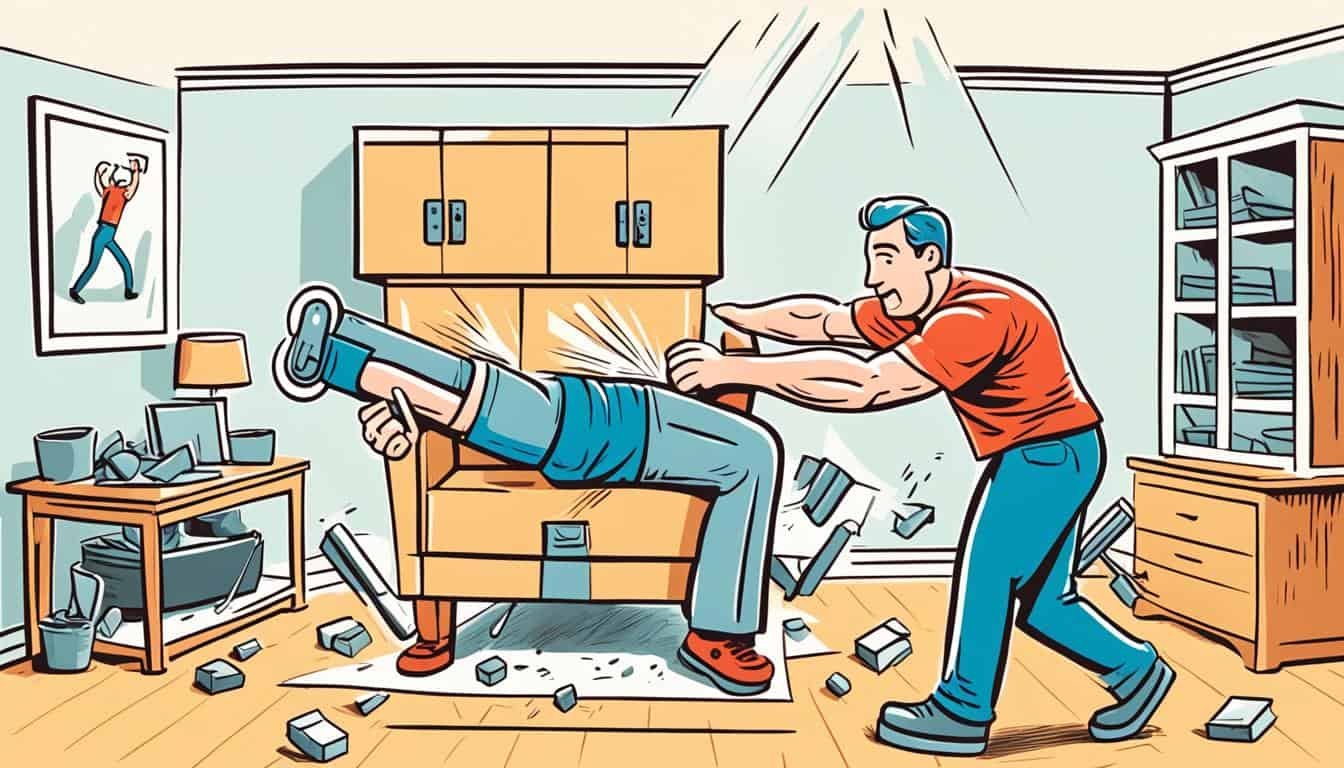Embarking on a DIY furniture moving adventure in South Africa may initially sound like a daunting task, but with strategic planning and the right know-how, it’s entirely feasible to manage this challenge single-handedly. Whether you’re rearranging spaces within your current home or transitioning to a new abode, mastering the art of moving heavy furniture solo not only empowers you but also saves costs. By diving into the depths of single-handed furniture moving techniques, and absorbing tips for moving furniture by yourself, you can turn what seems like an overwhelming task into a series of manageable steps.
Understanding how to move furniture alone involves grasping the fundamentals of safe lifting and maneuvering, as well as employing efficient tools crafted for the very purpose of making your moving experience smoother and injury-free. While moving heavy furniture solo might appear as a monumental feat, with the proper guidance and techniques, it becomes a surmountable objective, ensuring the preservation of your furniture and well-being.
Key Takeaways
- Plan ahead and familiarize yourself with safe and effective single-handed furniture moving techniques.
- Incorporate the correct tools and equipment to facilitate a smoother furniture relocation experience.
- Protect your back and joints by learning the best practices for how to move heavy items with care.
- Ensure to clear your moving path to prevent potential accidents and streamline the moving process.
- Keep your furniture safe from damage by using the appropriate protective wrapping and padding.
- Consider the complexity of your move – asking for help with extreme weights or awkward shapes can be prudent.
- Remember that efficiency and safety are paramount when undertaking any DIY furniture moving project solo.
Preparation is Key: Setting the Stage for Solo Furniture Moving
Embarking on the challenge of Managing furniture relocation solo requires meticulous preparation to ensure safety and efficiency. A well-organized environment sets the tone for a successful moving adventure, ensuring you’re equipped to safely lift and move furniture alone.
Clearing the Path for Seamless Movement
One of the best practices for moving furniture solo involves the crucial step of clearing any potential obstacles from your path. Cluttered hallways and rooms can create hazards that not only pose a risk to your physical well-being but can also result in damage to your furniture.
- Remove small items like rugs, decorations, and loose cables that might trip you.
- Ensure the doorways are wide enough for the furniture to pass through, and temporarily remove doors if necessary.
- Plan your route carefully, considering the size and shape of the furniture.
Dress for Success: Attire that Facilitates Movement
What you wear on moving day plays a significant role in how effectively you can safely lift and move furniture alone. Opting for the right clothing and footwear can prevent injuries and give you the mobility you need when moving furniture by yourself.
- Choose closed-toed shoes with non-slip soles to avoid slips and falls.
- Select garments that are snug yet flexible to avoid catching or tearing on objects.
- Don’t forget gloves to protect your hands and improve grip on bulky items.
| Attire Item | Description | Purpose |
|---|---|---|
| Footwear | Closed-toe, non-slip | Prevents foot injuries and slipping while moving |
| Clothing | Light, breathable, and snug | Facilitates ease of movement and prevents snags |
| Gloves | Durable with a good grip | Protects hands and improves hold on furniture |
By adopting these tips for moving furniture by yourself, you’re not just preparing for the physical task ahead, but also cultivating a proactive mindset that will drive a successful solo move. Remember, careful planning and preparation are the bedrock upon which safe and efficient DIY moving is built.
Can I move furniture on my own?
Embarking on a DIY journey to reposition your living quarters might seem like an uphill battle, especially when you’re looking to maneuver hefty items without extra hands. However, with the inclusion of certain hardware and mindful strategies, the solo act of moving heavy furniture can transform from an ordeal into a manageable solo task. Let’s dive into the assortment of essential tools and precautionary measures that can make this process smoother and safeguard your belongings along the way.
Essential Tools and Equipment for Single-Handed Moving
When preparing for DIY furniture moving, gathering the right toolkit can be your strongest ally. Here are some indispensable elements designed to assist you in moving heavy furniture solo:
- Dollies – Offering a stable platform and wheels, a dolly is crucial for transporting large and heavy items.
- Ramps – Employ these inclined planes to move items to higher surfaces without lifting them entirely.
- Moving Straps – These straps allow you to connect with the item firmly and leverage your body’s strength more effectively.
- Work Gloves – A pair of gloves can protect your hands and ensure a better grip on slippery surfaces.
- Sliders – Slipping these beneath your furniture legs can greatly reduce friction on floors, making pieces much easier to push.
Protective Measures to Safeguard Your Furniture and Premises
In the whirlwind that is single-handed furniture moving, the well-being of your furniture and the integrity of your space shouldn’t be overlooked. Below are key actions you can take to protect your valuables through the process:
- Wrap furniture in plastic or bubble wrap to shield against dust, scratches, and potential tears.
- Use furniture pads and cardboard to defend flooring and walls from abrasions.
Following these tips for moving furniture by yourself ensures that your solo mission is conducted with minimized risk and optimized safety—resulting in your belongings and your home remaining pristine.

| Tool | Function | Benefit |
|---|---|---|
| Dolly | Wheeled platform for heavy items | Reduced physical strain |
| Ramps | Assists in elevating items | Eliminates lifting on stairs |
| Moving Straps | Aids in securing and lifting | Improved weight distribution |
| Work Gloves | Hand protection and grip | Enhanced control and safety |
| Sliders | Minimizes friction with floors | Effortless furniture movement |
Techniques and Strategies for the Solo Mover
When it comes to DIY furniture moving, mastering the art of single-handed furniture moving techniques is essential. Before embarking on the task of how to move furniture alone, it’s imperative to familiarize oneself with the proper methods to avoid injury and ensure a smooth operation. The following strategies are pivotal for those who find themselves navigating the cumbersome task of safely lifting and moving furniture alone.
Bend at the knees, not the waist. This cardinal rule of lifting keeps your center of gravity low and reduces strain on your lower back. Ensure you have a firm grip on the furniture and keep it close to your body to maintain balance. Moving slowly and steadily, visualize your path before taking the first step to avoid any potential hazards.
Always clear your path of obstructions before moving any piece of furniture. The chances of a safe and successful move greatly increase when you have a clean and clear route.
Disassembling furniture can greatly lighten your load. Remove drawers, detachable shelves, and legs from tables whenever possible. Not only does this make the item easier to carry, but it also prevents the unnecessary sway and wobble that can lead to loss of control or damage to the furniture.
Use the right equipment for your solo move:
- Dollies and hand trucks enable you to roll heavy items instead of carrying them.
- Moving straps can help distribute weight more evenly across your body.
- Furniture sliders placed under legs allow you to glide pieces across floors with minimal effort.
| Moving Task | Equipment | How it helps |
|---|---|---|
| Carrying heavy load | Moving Straps | Reduces back strain, distributes weight |
| Maneuvering stairs | Hand Truck | Provides stability and leverages weight |
| Sliding furniture | Furniture Sliders | Prevents floor scratches, reduces push/pull force |
| Lifting bulky items | Dolly | Rolls heavy objects with ease |
Remember, while how to move furniture alone may seem daunting, incorporating these DIY furniture moving strategies will facilitate a more manageable and hazard-free moving experience. And if at any point, a particular task seems too risky to handle solo, do not hesitate to seek help to preserve both your safety and the integrity of your furniture.
Conclusion
Embarking on the journey of managing furniture relocation solo in South Africa is no small feat. It demands not just physical strength but also meticulous planning. Key to a successful move is the diligent preparation that starts long before the first piece of furniture is lifted. Gearing up with the right tools, designating a clear path for transport, and mastering safe lifting techniques form the cornerstone of a do-it-yourself move.
Employing the best practices for moving furniture solo, as outlined throughout this guide, increases your odds of a smooth transition from one space to another. It’s about more than just muscle; it’s about using your head. From the strategic use of sliders and dollies to enlisting the help of friends for the trickier segments, like tightly wound staircases, every step has been geared toward maximizing efficiency while minimizing potential strain and damage.
As you conclude the process of relocation, remember to take the time to reassess your techniques and the overall experience. Rest is as important as the move itself; it aids in your recovery and ensures you return to your normal activities without unnecessary discomfort or injury. With these tips for moving furniture by yourself, a solo relocation in South Africa can morph from an overwhelming task into a gratifying accomplishment, so long as patience and caution remain your close allies.
FAQ
Can I move furniture on my own?
Yes, it is possible to move furniture on your own with the right preparation, tools, and techniques. However, it is vital to understand the risks and to use proper lifting methods to avoid injury and damage. It may also be helpful to enlist the assistance of movers and furniture disassembly services to ensure the safety and efficiency of the process. This way, you can minimize the risk of injury and protect your furniture from damage. By properly planning and utilizing the right resources, you can successfully move your furniture without the need for professional help.
What are the key tips for DIY furniture moving?
Key tips include planning ahead, clearing pathways, wearing appropriate attire, utilizing moving equipment like dollies and straps, and employing safe lifting techniques. Ensuring that you are physically capable and taking breaks when needed is also crucial.
How do I prepare my space for moving heavy furniture solo?
Clear any obstacles from your pathways, secure loose rugs, contain pets, and ensure children are safe to prevent any tripping hazards. It helps to create as much space as possible to facilitate easy maneuvering of furniture.
What kind of attire is suitable for moving furniture by myself?
Wear light, breathable, and flexible clothing that allows for unimpeded movement. Closed-toe shoes with a non-slip sole are essential to protect your feet and prevent slipping while moving heavy items.
What are the essential tools I need for moving furniture alone?
Essential tools may include a furniture dolly, moving straps, furniture sliders, ramps, and work gloves. Using these tools helps in reducing the strain on your body and preventing damage to your furniture and premises.
How can I protect my furniture and premises during the move?
Use furniture pads, blankets, bubble wrap, and plastic wrap to cover and secure your furniture. For floor and wall protection, lay down cardboard or protective sheets to prevent scratches and dents during the move.
What are the best practices for safely lifting and moving furniture alone?
Always lift with your legs, not your back, to avoid strain or injury. Keep your movements slow and controlled, hold items close to your body for stability, and make sure that your visibility is not obstructed. For particularly heavy or awkward pieces, disassembly may be the best option.
How can I manage furniture relocation solo safely?
Alongside using the right tools and techniques, ensure you assess the weight and size of your furniture, take your time, and plan your route. If an item is too heavy or the move is too complex, don’t hesitate to ask for help to prevent accidents.
Are there any strategies for moving furniture downstairs alone?
When moving furniture downstairs solo, use tools like a hand truck and secure the furniture with straps. Go slowly, step by step, and if possible, slide the piece down on a blanket with the heavier end going down first. However, asking for assistance is advisable for safety.





